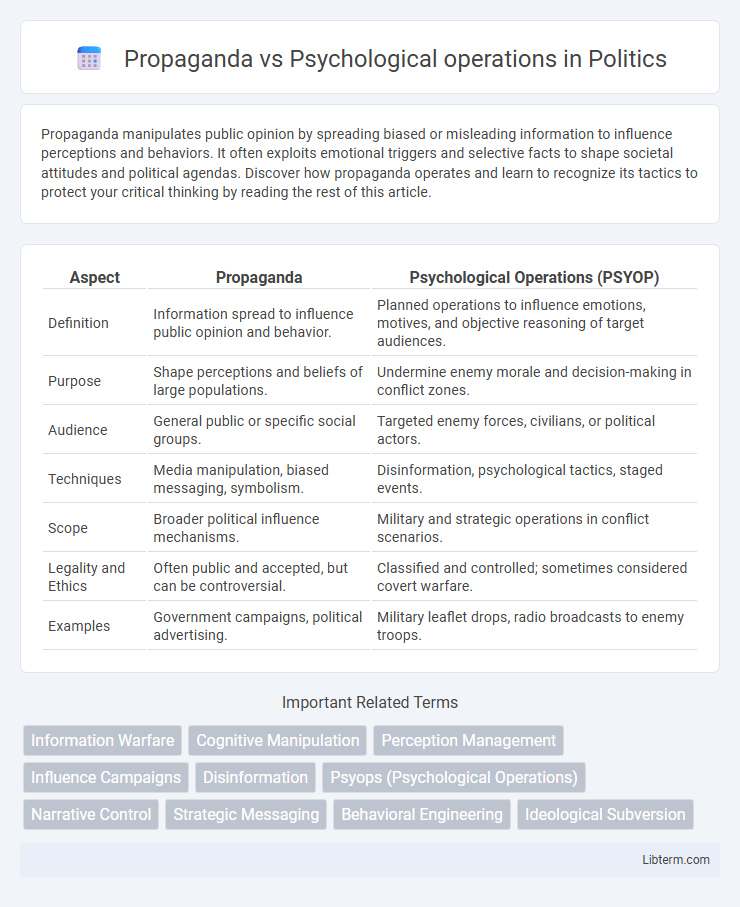Propaganda manipulates public opinion by spreading biased or misleading information to influence perceptions and behaviors. It often exploits emotional triggers and selective facts to shape societal attitudes and political agendas. Discover how propaganda operates and learn to recognize its tactics to protect your critical thinking by reading the rest of this article.
Table of Comparison
| Aspect | Propaganda | Psychological Operations (PSYOP) |
|---|---|---|
| Definition | Information spread to influence public opinion and behavior. | Planned operations to influence emotions, motives, and objective reasoning of target audiences. |
| Purpose | Shape perceptions and beliefs of large populations. | Undermine enemy morale and decision-making in conflict zones. |
| Audience | General public or specific social groups. | Targeted enemy forces, civilians, or political actors. |
| Techniques | Media manipulation, biased messaging, symbolism. | Disinformation, psychological tactics, staged events. |
| Scope | Broader political influence mechanisms. | Military and strategic operations in conflict scenarios. |
| Legality and Ethics | Often public and accepted, but can be controversial. | Classified and controlled; sometimes considered covert warfare. |
| Examples | Government campaigns, political advertising. | Military leaflet drops, radio broadcasts to enemy troops. |
Understanding Propaganda: Definition and Key Elements
Propaganda is a strategic communication tool designed to influence public opinion by disseminating biased or misleading information to promote a specific agenda. Key elements include emotional appeal, repetition, symbolism, and selective presentation of facts to shape perceptions and behaviors. Unlike psychological operations, which often target military or tactical objectives, propaganda primarily aims to sway civilian populations on a broader sociopolitical scale.
Psychological Operations: An Overview
Psychological operations (PSYOP) are strategic activities aimed at influencing the perceptions, emotions, and behaviors of target audiences to achieve specific objectives, often in military or political contexts. These operations employ various communication techniques, including misinformation, persuasion, and cultural manipulation, designed to exploit vulnerabilities and shape decision-making processes. Unlike propaganda, PSYOP are carefully tailored to specific groups with clear psychological objectives to degrade enemy morale or win support among civilian populations.
Historical Evolution of Propaganda Techniques
Propaganda techniques have evolved from crude posters and pamphlets in ancient civilizations such as Egypt and Rome to sophisticated multimedia campaigns during World Wars I and II, utilizing film, radio, and printed materials to influence public opinion. The advent of digital technology further transformed propaganda into highly targeted and data-driven psychological operations, leveraging social media platforms and AI algorithms to manipulate emotions and behaviors on a large scale. Historical progression highlights the transition from overt government messaging to subtle psychological tactics designed to exploit cognitive biases and shape collective narratives.
The Objectives of Psychological Operations
Psychological Operations (PSYOP) aim to influence the emotions, motives, reasoning, and behavior of target audiences to achieve strategic, operational, or tactical objectives. Unlike propaganda, which often targets broad audiences with ideological messages, PSYOP target specific groups to disrupt enemy decision-making, erode morale, and gain support from friendly or neutral populations. Key objectives include shaping perceptions, fostering support for military or political goals, and undermining adversaries' will to fight.
Methods and Tools Used in Propaganda
Propaganda employs methods such as repetition, emotional appeals, and selective information presentation to shape public opinion, utilizing tools like mass media, social media platforms, posters, and speeches for wide dissemination. It often relies on visual imagery, slogans, and symbols to reinforce messages and create strong associations in the audience's mind. The strategic use of misinformation, half-truths, and framing techniques enhances the persuasive impact of propaganda in influencing beliefs and behaviors.
Psychological Operations in Modern Conflicts
Psychological operations (PSYOP) in modern conflicts leverage advanced technologies and social media platforms to influence enemy morale, disrupt decision-making, and sway public opinion on a global scale. Unlike traditional propaganda, PSYOP employs targeted messaging tailored to specific cultural, linguistic, and psychological profiles to maximize impact and reduce operational costs. Integration with cyber warfare and intelligence enables real-time adaptation and precision in shaping battlefield narratives and strategic outcomes.
Key Differences Between Propaganda and Psychological Operations
Propaganda primarily aims to influence public opinion through biased or misleading information, often targeting civilian populations to shape attitudes and beliefs. Psychological operations (PSYOP) involve strategic use of information and tactics to influence the emotions, motives, and behavior of enemy forces and civilian groups during military operations. Key differences include propaganda's broad societal focus versus PSYOP's targeted military objectives, with PSYOP employing tailored messaging to achieve specific operational goals.
Impact on Public Opinion and Behavior
Propaganda and psychological operations both aim to influence public opinion and behavior but differ in scope and methods; propaganda primarily uses biased or misleading information to shape mass perception, while psychological operations employ targeted psychological tactics to manipulate emotions and decision-making processes. The impact on public opinion from propaganda often involves widespread acceptance of a specific narrative, reinforcing existing beliefs or creating new social norms. Psychological operations tend to produce more immediate and covert behavioral changes by exploiting cognitive vulnerabilities and emotional triggers within specific populations.
Ethical Considerations and Controversies
Propaganda often involves biased or misleading information to influence public perception, raising ethical concerns about manipulation and truth distortion. Psychological operations (PSYOPs) employ targeted communication tactics aimed at affecting the emotions, motives, and behavior of specific audiences, sparking debates on consent and potential harm to civilian populations. Both practices face controversies regarding transparency, accountability, and the balance between national security interests and respect for human rights.
Future Trends in Information Warfare
Future trends in information warfare emphasize the convergence of propaganda and psychological operations through advanced AI-driven targeting and deepfake technologies, enhancing message personalization and credibility. Emerging cyber capabilities enable real-time influence across social media platforms, exploiting cognitive biases and emotional triggers to destabilize societies. Integration of neurotechnology and augmented reality promises more immersive psychological manipulation, escalating the complexity and scope of information conflicts.
Propaganda Infographic

 libterm.com
libterm.com